Investigation of Multi-Timescale Sea Level Variability near Jamaica in the Caribbean Using Satellite Altimetry Records
Abstract
1. Introduction
2. Data and Methodology
2.1. Geographical Setting
2.2. Data
| (a) Data Type | Details | Length | Source | Reference |
| Tide Gauge | Station data of relative sea level rise for Cuba, Haiti, Puerto Rico, Dominica, Grenada. | Varying Record Lengths | University of Hawaii Sea Level Centre. Retrieved from: http://uhslc.soest.hawaii.edu/data/ (accessed on 16 March 2020). | [23,48] |
| Satellite Altimetry | Daily Data Sea surface height above mean Sea Surface (‘sla’ sea level anomaly). 0.25° × 0.25° Gridded Dataset. | 1993–2019 | Copernicus Climate Change Service (C3S): https://cds.climate.copernicus.eu/cdsapp#!/dataset/satellite-sea-level-global?tab=overview (accessed on 5 September 2019). | [42,49] |
| Sea Surface Temperature | Extended Reconstructed Sea Surface Temperature (ERSST) v5 Monthly 2.0° × 2.0° Gridded Dataset. | 1993–2019 | https://www.ncdc.noaa.gov/data-access/marineocean-data/extended-reconstructed-sea-surface-temperature-ersst-v5 (accessed on 2 November 2022). | [50] |
| Surface Wind | European Centre for Medium-Range Weather Forecasts (ECMWF) ERA5 climate reanalysis. Reanalysis, land based zonal and meridional wind dataset from 1990–2020. 9 km resolution. Monthly. | 1993–2019 | https://cds.climate.copernicus.eu/cdsapp#!/dataset/reanalysis-era5-land-monthly-means?tab=overview (accessed on 2 November 2022). | [50,51] |
| (b) Climate/Ocean Indices and Variables | Description | Period | Source | Reference |
| Caribbean Sea Surface Temperature (Carib SST) | Caribbean Index (CAR). Carib SST Anomaly averaged over 10°–25° N, 100°–60° W. | 1950–2019 | Derived using ERSSTv5 Monthly anomaly data (see above) | [17,52] |
| Nino3.0 | Eastern Tropical Pacific SST Anomaly averaged over 5° N–5° S, 150°–90° W. | 1950–2020 | Derived using ERSSTv5 Monthly anomaly data (see above) | [17,23] |
| Nino3.4 | Anomaly average SST in Nino3.4 Region (5° N–5° S, 120°–170° W) | 1950–2020 | Derived using ERSSTv5 Monthly anomaly data (see above) | |
| Jamaica Wind | Surface wind anomaly at 18.038° N, 76.849° W. | 1990–2020 | Derived using ECMWF ER5 Monthly climate reanalysis data (see above) | [50,53] |
| Caribbean Low Level Jet (CLLJ) | The CLLJ index is an anomaly mean of the easterly zonal wind at 925 hPa in the CLLJ emergence region (11.25°–18.75° N, 81.25°–68.75° W). The CLLJ is located south of Jamaica. | 1949–2020 | US Weather Service—National Met. Center via NOAA NCEP-NCAR CDAS-1 database obtained from: http://iridl.ldeo.columbia.edu/SOURCES/.NOAA/.NCEP-NCAR/.CDAS-1/.MONTHLY/.Intrinsic/.PressureLevel/.u/P/925/VALUE/Y/12.5/17.5/RANGE/X/-80/-70/RANGE/[X/Y]average/dup/T/(1981)/(2010)/RANGE/[T]average/sub/-1/mul/DATA/-10/10/RANGE//name//cllji/def//long_name/(Caribbean%20Low%20Level%20Jet%20Index)/def/dup/index.html (accessed on 9 September 2021). | [45,54,55,56] |
| Sea Level Pressure (SLP) | Reanalysis data of mean sea level pressure at 17.5° N, 77.5° W. Gridded monthly reanalysis dataset at 2.5° × 2.5° resolution. | 1949–2020 | Extracted from US Weather Service—National Met. Center’s NOAAData Obtained from: http://iridl.ldeo.columbia.edu/SOURCES/.NOAA/.NCEP-NCAR/.CDAS-1/.MONTHLY/.Intrinsic/.MSL/.pressure/ (accessed on 9 September 2021). | [56] |
| Pacific Decadal Oscillation (PDO) | Long-term climate variability phenomenon centred around the North Pacific and produced from analysis of SST anomalies in this region. | 1950–2019 | NOAA Database obtained from: https://psl.noaa.gov/data/climateindices/list (accessed on 9 September 2021). | [30] |
| Atlantic Multidecadal Oscillation (AMO) | Multi-decadal cycle of sea surface temperatures in the Pacific Ocean characterised by warm and cool phases. | 1950–2020 | NOAA Physical Sciences Laboratory. Data obtained from: http://www.psl.noaa.gov/data/timeseries/AMO (accessed on 9 September 2021). | [57,58] |
| North Atlantic Oscillation (NAO) | Large scale atmospheric teleconnection pattern associated with pressure differences in North Atlantic. | 1950–2020 | NOAA Climate Prediction Centre. Dat aobtained from:https://www.cpc.ncep.noaa.gov/products/precip/CWlink/pna/nao.shtml (accessed on 10 September 2021). | [59] |
| Pacific-Atlantic Sea Surface Temperature Gradient (Pacific-Atl) | SST gradient index calculated using the difference in the SST anomalies in the Nino 3.0 region of the Pacific (5° N–5° S, 150°–90° W) and the Tropical North Atlantic (6° S–22° N, 80°–15° W). A known modulator of Caribbean rainfall. | 1993–2019 | Index was produced using ERSSTv5 SST datasets. Obtained from https://www.ncdc.noaa.gov/data-access/marineocean-data/extended-reconstructed-sea-surface-temperature-ersst-v5 (accessed on 10 September 2021). | [45,55,58] |
| Tide Gauge | Location | Correlation Coefficient | Period of Overlap | Distance to Nearest Grid Corner from Tide Gauge (km) | |
|---|---|---|---|---|---|
| Tide Gauge | Altimetry Grid Box | ||||
| Port-au Prince, Haiti | 18.567° N, 72.350° W | 18.625° N, 72.625° W | 0.35 | 2012–2015 | 7.02 |
| San Juan, Puerto Rico | 18.460° N, 66.117° W | 18.875° N, 66.125° W | 0.89 | 2000–2008 | 18.37 |
| Prickley Bay, Grenada | 12.005° N, 61.765° W | 12.125° N, 61.875° W | 0.77 | 2012–2015 | 18.01 |
| Roseau, Dominica | 15.313° N, 61.390° W | 15.375° N, 61.625° W | 0.74 | 2014–2016 | 27.02 |
| Cabo Cruz, Cuba | 19.833° N, 77.733° W | 19.875° N, 77.875° W | 0.81 | 1993–2019 | 16.47 |
2.3. Methodology
3. Results
3.1. Satellite Altimetry Validation
3.2. Sea Level Characteristics for Jamaica
3.3. Variability and Drivers
3.3.1. EOF Analysis of the Raw Versus Detrended Data
3.3.2. EOF Analysis of the Deseasoned Versus Detrended and Deseasoned Data
3.3.3. Summer Season
3.4. Composites
4. Discussion
5. Conclusions
Author Contributions
Funding
Institutional Review Board Statement
Informed Consent Statement
Data Availability Statement
Acknowledgments
Conflicts of Interest
Appendix A
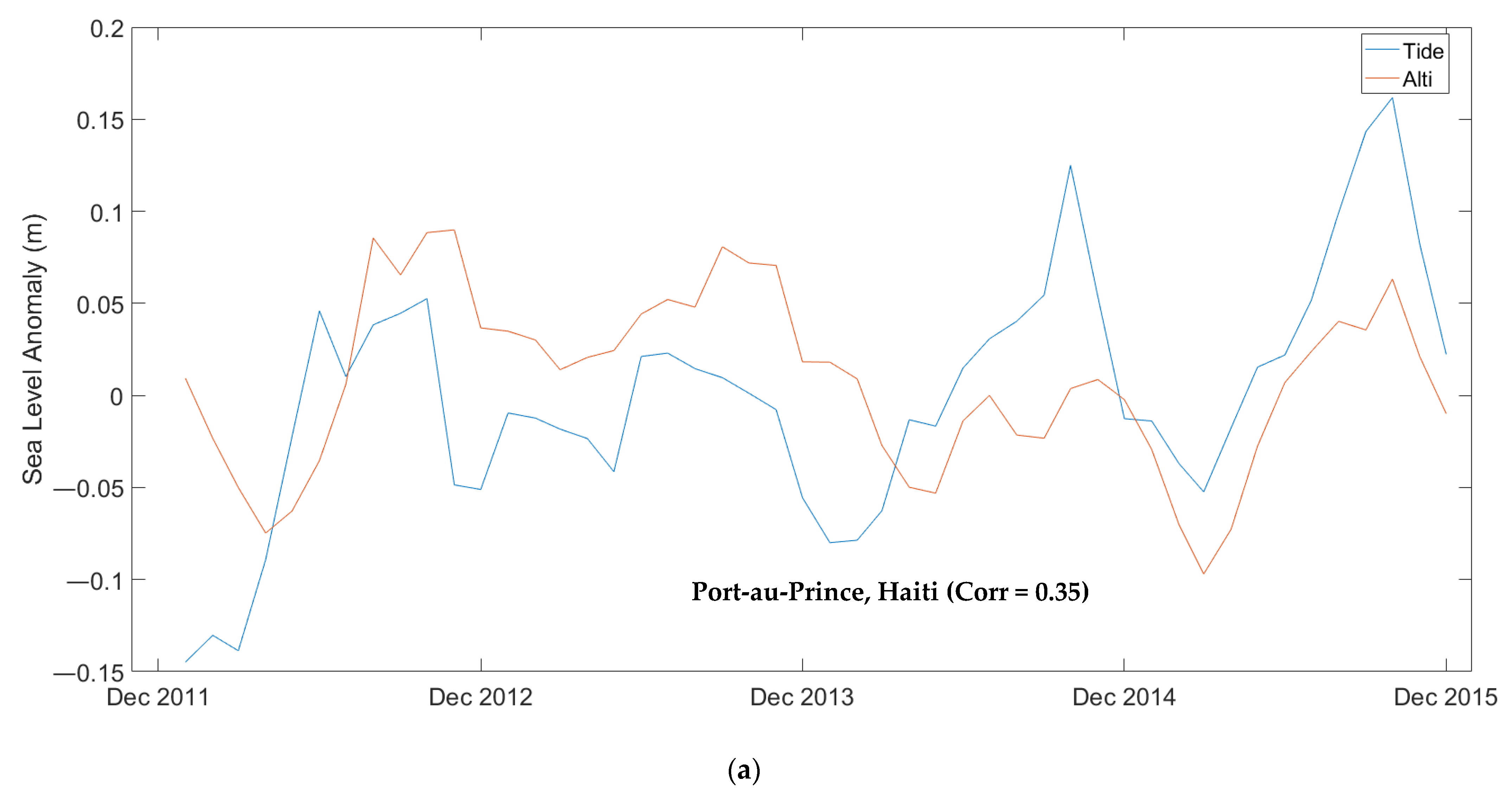


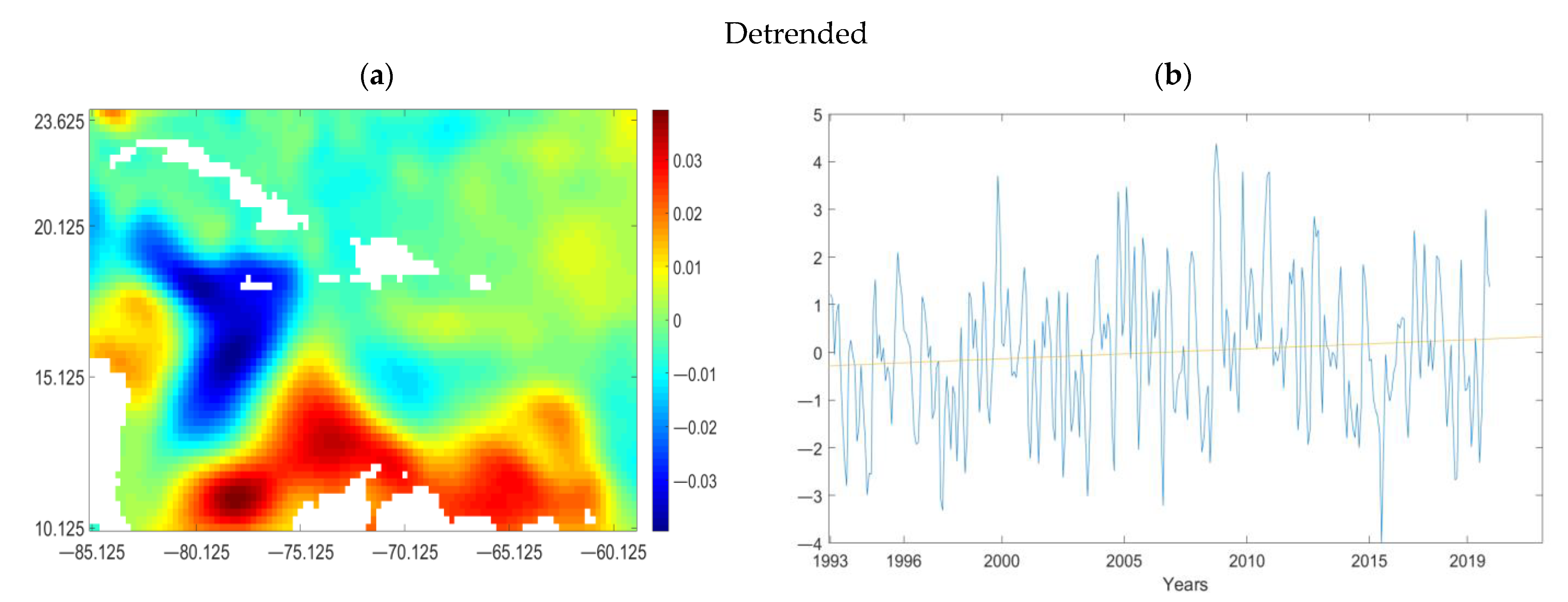
References
- Bueno, R.; Herzfeld, C.; Stanton, E.A.; Ackerman, F. The Caribbean and climate change: The costs of inaction. Stockholm Environment Institute, US Center and Global Development and Environment Institute, Tufts University (2008). Available online: https://tamug-ir.tdl.org/bitstream/handle/1969.3/29240/Caribbean-full-Eng.pdf?sequence=1 (accessed on 12 December 2019).
- Macpherson, C.; Akpinar-Elci, M. Impacts of climate change on Caribbean life. Am. J. Public Health 2013, 103, 2013. [Google Scholar] [CrossRef]
- Reguero, B.G.; Losada, I.J.; Díaz-Simal, P.; Méndez, F.J.; Beck, M.W. Effects of climate change on exposure to coastal flooding in Latin America and the Caribbean. PLoS ONE 2015, 10, e0133409. [Google Scholar] [CrossRef]
- Dasgupta, S.; Laplante, B.; Meisner, C.; Wheeler, D.; Yan, J. The impact of sea level rise on developing countries: A comparative analysis. Clim. Chang. 2009, 93, 379–388. [Google Scholar] [CrossRef]
- Richards, A. Development Trends in Jamaica’s Coastal Areas and the Implications for Climate Change. Sustainable Development and Regional Planning Division, Planning Institute of Jamaica. 2008. Available online: https://www.pioj.gov.jm/Portals/0/Sustainable_Development/Climate%20Change%20and%20Jamaica.pdf (accessed on 19 June 2021).
- Sheller, M. Reconstructing tourism in the Caribbean: Connecting pandemic recovery, climate resilience and sustainable tourism through mobility justice. J. Sustain. Tour. 2020, 29, 1436–1449. [Google Scholar] [CrossRef]
- Jayawardena, C.; Ramajeesingh, D. Performance of tourism analysis: A Caribbean perspective. Int. J. Contemp. Hosp. Manag. 2003, 15, 176–179. [Google Scholar] [CrossRef]
- Mackay, E.A.; Spencer, A. The future of Caribbean tourism: Competition and climate change implications. Worldw. Hosp. Tour. Themes 2017, 9, 44–59. [Google Scholar] [CrossRef]
- Banton, J.D.; Dowding, D.D. Caribbean storm surge mapping—An overview towards guidelines. In Proceedings of the Institution of Civil Engineers: Maritime Engineering; ICE Publishing: London, UK, 2013; Volume 166, pp. 3–13. [Google Scholar] [CrossRef]
- Simpson, M.; Scott, D.; New, M.G.; Sim, R.; Smith, D.; Harrison, M.; Eakin, C.M.; Warrick, R.; Strong, A.E.; Kouwenhoven, P.; et al. An Overview of Modelling Climate Change: Impacts in the Caribbean Region with contribution from the Pacific Islands. 2009. Available online: https://coralreefwatch.noaa.gov/satellite/publications/UNDP_Final_Report.pdf (accessed on 30 May 2023).
- IPCC. Global Warming of 1.5 °C; An IPCC Special Report on the Impacts of Global Warming of 1.5 °C above Pre-Industrial Levels and Related Global Greenhouse Gas Emission Pathways, in the Context of Strengthening the Global Response to the Threat of Climate Change; Blackwell Publishing Ltd.: Oxford, UK, 2018; Available online: https://www.ipcc.ch/site/assets/uploads/sites/2/2019/06/SR15_Full_Report_High_Res.pdf (accessed on 30 May 2023). [CrossRef]
- Fox-Kemper, B.; Hewitt, H.; Xiao, C.; Aðalgeirsdóttir, G.; Drijfhout, S.; Edwards, T.; Golledge, N.; Hemer, M.; Kopp, R.; Krinner, G.; et al. Ocean, Cryosphere and Sea Level Change. In Climate Change 2021: The Physical Science Basis; Contribution of Working Group I to the Sixth Assessment Report of the Intergovernmental Panel on Climate Change Science Basis; Cambridge University Press: Cambridge, UK; New York, NY, USA, 2021; Volume 2018. [Google Scholar]
- Kopp, R.E.; Horton, R.M.; Little, C.M.; Mitrovica, J.X.; Oppenheimer, M.; Rasmussen, D.J.; Strauss, B.H.; Tebaldi, C. Probabilistic 21st and 22nd century sea-level projections at a global network of tide-gauge sites. Earths Future 2014, 2, 383–406. [Google Scholar] [CrossRef]
- Milne, G.A.; Gehrels, W.R.; Hughes, C.W.; Tamisiea, M.E. Identifying the causes of sea-level change. Nat. Geosci. 2009, 2, 471–478. [Google Scholar] [CrossRef]
- Passaro, M.; Müller, F.L.; Oelsmann, J.; Rautiainen, L.; Dettmering, D.; Hart-Davis, M.G.; Abulaitijiang, A.; Andersen, O.B.; Høyer, J.L.; Madsen, K.S.; et al. Absolute Baltic Sea Level Trends in the Satellite Altimetry Era: A Revisit. Front. Mar. Sci. 2021, 8, 1–16. [Google Scholar] [CrossRef]
- Jaggan, S.; Davis, D. Evaluating Satellite Altimetry for Monitoring Caribbean Sea Level Rise. West Indian J. Eng. 2012, 35, 66–72. Available online: https://sta.uwi.edu/eng/wije/vol3501_jul2012/documents/EvaluatingSatelliteAltimetry.pdf (accessed on 5 September 2019).
- Palanisamy, H.; Becker, M.; Meyssignac, B.; Henry, O.; Cazenave, A. Regional sea level change and variability in the Caribbean sea since 1950. J. Geod. Sci. 2012, 2, 125–133. [Google Scholar] [CrossRef]
- WCRP Global Sea Level Budget Group. Global sea-level budget 1993–present. Earth Syst. Sci. Data 2018, 1, 1551–1590. [Google Scholar]
- Woodruff, J.D.; Irish, J.L.; Camargo, S.J. Coastal flooding by tropical cyclones and sea-level rise. Nature 2013, 504, 44–52. [Google Scholar] [CrossRef]
- Alvera-Azcárate, A.; Barth, A.; Weisberg, R.H. The surface circulation of the Caribbean Sea and the Gulf of Mexico as inferred from satellite altimetry. J. Phys. Oceanogr. 2009, 39, 640–657. [Google Scholar] [CrossRef]
- Torres, R.R.; Tsimplis, M.N. Seasonal sea level cycle in the Caribbean Sea. J. Geophys. Res. Oceans 2012, 117, 1–18. [Google Scholar] [CrossRef]
- Miller, K.; Hart, B.; Sydney, P. Sea levels around Barbados from tide gauges and satellite altimetry. Surv. Rev. 2012, 44, 215–222. [Google Scholar] [CrossRef]
- Torres, R.R.; Tsimplis, M.N. Sea-level trends and interannual variability in the Caribbean Sea. J. Geophys. Res. Oceans 2013, 118, 2934–2947. [Google Scholar] [CrossRef]
- Jury, M.R. Puerto Rico sea level trend in regional context. Ocean Coast. Manag. 2018, 163, 478–484. [Google Scholar] [CrossRef]
- Serju, C. A Beloved Jamaican Beach Is Succumbing to Climate Change. It Won’t Be the Last. The Guardian, 27 October 2020. p. 27. Available online: https://www.theguardian.com/us-news/2020/oct/27/jamaica-hellshire-beach-climate-change (accessed on 30 May 2023).
- Robinson, E.; Khan, S.; Coutou, R.; Johnson, M. Shoreline changes and sea-level rise at Long Bay, Negril, western Jamaica. Caribb. J. Earth Sci. 2012, 43, 35–49. [Google Scholar]
- Lyew-Ayee, P.; Maxam, A.; Mishiro, K.; Lyew-Ayee, A. Son of a Beach: Jamaica and the Coastal Zone. 2015. Available online: http://demo.monagis.com/EFJ%2010th%20Annual%20Public%20Lectue%20Booklet.pdf (accessed on 6 August 2021).
- Monioudi, I.; Asariotis, R.; Becker, A.; Bhat, C.; Dowding-Gooden, D.; Esteban, M.; Feyen, L.; Mentaschi, L.; Nikolaou, A.; Nurse, L.; et al. Climate change impacts on critical international transportation assets of Caribbean Small Island Developing States (SIDS): The case of Jamaica and Saint Lucia. Reg. Environ. Chang. 2018, 18, 2211–2225. [Google Scholar] [CrossRef]
- Simpson, S.; Clarke, M.C.; Scott, J.F.; New, D.J.; Karmalkar, M.; Day, A.; Taylor, O.J.; Gossling, M.; Wilson, S.; Chadee, M.; et al. The Caribsave Climate Change Risk Atlas (CCCRA)—Jamaica. 2012; Caribsave: Kent, UK.
- Gharineiat, Z.; Deng, X. Description and assessment of regional sea-level trends and variability from altimetry and tide gauges at the northern Australian coast. Adv. Space Res. 2018, 61, 2540–2554. [Google Scholar] [CrossRef]
- Forget, G.; Ponte, R.M. The partition of regional sea level variability. Prog. Oceanogr. 2015, 137, 173–195. [Google Scholar] [CrossRef]
- Boschat, G.; Simmonds, I.; Purich, A.; Cowan, T.; Pezza, A.B. On the use of composite analyses to form physical hypotheses: An example from heat wave—SST associations. Sci. Rep. 2016, 6, 29599. [Google Scholar] [CrossRef] [PubMed]
- Maldonado, T.; Rutgersson, A.; Amador, J.; Alfaro, E.; Claremar, B. Variability of the Caribbean low-level jet during boreal winter: Large-scale forcings. Int. J. Clim. 2016, 36, 1954–1969. [Google Scholar] [CrossRef]
- Richardson, P.L. Caribbean Current and eddies as observed by surface drifters. Deep. Sea Res. Part II Top. Stud. Oceanogr. 2005, 52, 429–463. [Google Scholar] [CrossRef]
- Heyman, W.D.; Cuevas, E.; Requena, N.; Garbutt, D.; Bolser, D.; Wade, B.; Olivares, M.; Kobara, S.; Welbrock, N.; Salceda, A.; et al. The Cayman Crown: Newly protected coral reefs at the edge of the Cayman Trench. Coral Reefs 2023, 42, 615–620. [Google Scholar] [CrossRef]
- Restrepo-Ángel, J.D.; Mora-Páez, H.; Díaz, F.; Govorcin, M.; Wdowinski, S.; Giraldo-Londoño, L.; Tosic, M.; Fernández, I.; Paniagua-Arroyave, J.F.; Duque-Trujillo, J.F. Coastal subsidence increases vulnerability to sea level rise over twenty first century in Cartagena, Caribbean Colombia. Sci. Rep. 2021, 11, 18873. [Google Scholar] [CrossRef]
- Gómez, J.F.; Kwoll, E.; Walker, I.J.; Shirzaei, M. Vertical land motion as a driver of coastline changes on a deltaic system in the colombian Caribbean. Geosciences 2021, 11, 300. [Google Scholar] [CrossRef]
- Domínguez-González, L.; Andreani, L.; Stanek, K.P.; Gloaguen, R. Geomorpho-tectonic evolution of the jamaican restraining bend. Geomorphology 2015, 228, 320–334. [Google Scholar] [CrossRef]
- Skrivanek, A.; Dutton, A.; Stemann, T.; Vyverberg, K.; Mitrovica, J.X. Evidence of tectonism based on differential uplift of the Falmouth Formation of Jamaica. GSA Bull. 2018, 130, 707–720. [Google Scholar] [CrossRef]
- James-Williamson, S.A.; Mitchell, S.F.; Ramsook, R. Tectono-stratigraphic development of the Coastal Group of south-eastern Jamaica. J. South Am. Earth Sci. 2014, 50, 40–47. [Google Scholar] [CrossRef]
- Khan, N.S.; Ashe, E.; Horton, B.P.; Dutton, A.; Kopp, R.E.; Brocard, G.; Engelhart, S.E.; Hill, D.F.; Peltier, W.; Vane, C.H.; et al. Drivers of Holocene sea-level change in the Caribbean. Quat. Sci. Rev. 2017, 155, 13–36. [Google Scholar] [CrossRef]
- Taburet, G.; Sanchez-roman, A.; Ballarotta, M.; Pujol, M.; Legeais, J. DUACS DT2018: 25 years of reprocessed sea level altimetry products. Ocean Sci. 2019, 2014, 1207–1224. [Google Scholar] [CrossRef]
- Pujol, M.-I.; Faugère, Y.; Taburet, G.; Dupuy, S.; Pelloquin, C.; Ablain, M.; Picot, N. DUACS DT2014: The new multi-mission altimeter data set reprocessed over 20 years. Ocean Sci. 2016, 12, 1067–1090. [Google Scholar] [CrossRef]
- Peltier, W.R. Global glacial isostasy and the surface of the ice-age earth: The ICE-5G (VM2) model and GRACE. Annu. Rev. Earth Planet. Sci. 2004, 32, 111–149. [Google Scholar] [CrossRef]
- Taylor, M.A.; Enfield, D.B.; Chen, A.A. Influence of the tropical Atlantic versus the tropical Pacific on Caribbean rainfall. J. Geophys. Res. Atmos. 2002, 107107, 3127. [Google Scholar] [CrossRef]
- Stephenson, T.S.; Vincent, L.A.; Allen, T.L.; Van Meerbeeck, C.J.; McLean, N.; Peterson, T.C.; Taylor, M.A.; Aaron-Morrison, A.P.; Auguste, T.; Bernard, D.; et al. Changes in extreme temperature and precipitation in the Caribbean region, 1961–2010. Int. J. Clim. 2014, 34, 2957–2971. [Google Scholar] [CrossRef]
- Spence, J.M.; Taylor, M.A.; Chen, A.A. The Effects of Concurrent Sea-Surface Temperature Anomalies in the Tropical Pacific and Atlantic on Caribbean Rainfall. Int. J. Climatol. 2004, 1541, 1531–1541. [Google Scholar] [CrossRef]
- Losada, I.J.; Reguero, B.G.; Méndez, F.J.; Castanedo, S.; Abascal, A.J.; Mínguez, R. Long-term changes in sea-level components in Latin America and the Caribbean. Glob. Planet. Chang. 2013, 104, 34–50. [Google Scholar] [CrossRef]
- Ablain, M.; Legeais, J.F.; Prandi, P.; Marcos, M.; Fenoglio-Marc, L.; Dieng, H.B.; Benveniste, J.; Cazenave, A. Satellite Altimetry-Based Sea Level at Global and Regional Scales. Surv. Geophys. 2017, 38, 7–31. [Google Scholar] [CrossRef]
- Hersbach, H.; Bell, B.; Berrisford, P.; Hirahara, S.; Horányi, A.; Muñoz-Sabater, J.; Nicolas, J.; Peubey, C.; Radu, R.; Schepers, D.; et al. The ERA5 global reanalysis. Q. J. R. Meteorol. Soc. 2020, 146, 1999–2049. [Google Scholar] [CrossRef]
- Barbariol, F.; Davison, S.; Falcieri, F.M.; Ferretti, R.; Ricchi, A.; Sclavo, M.; Benetazzo, A. Wind Waves in the Mediterranean Sea: An ERA5 Reanalysis Wind-Based Climatology. Front. Mar. Sci. 2021, 8, 760614. [Google Scholar] [CrossRef]
- Chang, P.; Ji, L.; Li, H.; Penland, C.; Matrosova, L. Prediction of tropical Atlantic sea surface temperature. Geophys. Res. Lett. 1998, 25, 1193–1196. [Google Scholar] [CrossRef]
- Soukissian, T.H.; Karathanasi, F.E.; Zaragkas, D.K. Exploiting offshore wind and solar resources in the Mediterranean using ERA5 reanalysis data. Energy Convers. Manag. 2021, 237, 114092. [Google Scholar] [CrossRef]
- Wang, C. Variability of the Caribbean Low-Level Jet and its relations to climate. Clim. Dyn. 2007, 29, 411–422. [Google Scholar] [CrossRef]
- Whyte, F.S.; Taylor, M.A.; Stephenson, T.S.; Campbell, J.D. Features of the Caribbean low level jet. Int. J. Climatol. 2008, 28, 119–128. [Google Scholar] [CrossRef]
- Jury, M.R. Long-Term Variability and Trends in the Caribbean Sea. Int. J. Oceanogr. 2011, 2011, 465810. [Google Scholar] [CrossRef]
- Antuña-Marrero, J.C.; Otterå, O.H.; Robock, A.; Mesquita, M.D.S. Modelled and observed sea surface temperature trends for the Caribbean and Antilles. Int. J. Clim. 2015, 36, 1873–1886. [Google Scholar] [CrossRef]
- Jones, J.J.; Stephenson, T.S.; Taylor, M.A.; Campbell, J.D. Statistical downscaling of North Atlantic tropical cyclone frequency and the amplified role of the Caribbean low-level jet in a warmer climate. J. Geophys. Res. Atmos. 2016, 121, 3741–3758. [Google Scholar] [CrossRef]
- Volkov, D.L.; Lee, S.-K.; Domingues, R.; Zhang, H.; Goes, M. Interannual Sea Level Variability Along the Southeastern Seaboard of the United States in Relation to the Gyre-Scale Heat Divergence in the North Atlantic. Geophys. Res. Lett. 2019, 46, 7481–7490. [Google Scholar] [CrossRef]
- Ablain, M.; Meyssignac, B.; Zawadzki, L.; Jugier, R.; Ribes, A.; Cazenave, A.; Picot, N. Uncertainty in Satellite estimate of Global Mean Sea Level changes, trend and acceleration. Earth Syst. Sci. Data Discuss. 2019, 2, 1–26. [Google Scholar] [CrossRef]
- Zhang, Z.; Moore, J.C. Empirical Orthogonal Functions. Mathematical and Physical Fundamentals of Climate Change; Elsevier: Amsterdam, The Netherlands, 2015; pp. 161–197. [Google Scholar] [CrossRef]
- Gravetter, F.J.; WaLLnau, L.B. Statistics for the Behavioral Sciences, 10th ed.; Cengage Learning: Boston, MA, USA, 2017. [Google Scholar]
- Field, A. An Adventure in Statistics; SAGE Publications Ltd.: London, UK, 2016. [Google Scholar]
- Hipel, A.I.; McLeod, K.W. Time Series Modelling of Water Resources and Environmental Systems; Elsevier: Amsterdam, The Netherlands, 1994. [Google Scholar]
- Welhouse, L.J.; Lazzara, M.A.; Keller, L.M.; Tripoli, G.J.; Hitchman, M.H. Composite analysis of the effects of ENSO events on Antarctica. J. Clim. 2016, 29, 1797–1808. [Google Scholar] [CrossRef]
- Taylor, M.A.; Stephenson, T.S.; Owino, A.; Chen, A.A.; Campbell, J.D. Tropical gradient influences on Caribbean rainfall. J. Geophys. Res. Atmos. 2011, 116, 1–14. [Google Scholar] [CrossRef]
- Wang, X.; Liu, H.; Foltz, G.R. Persistent influence of tropical North Atlantic wintertime sea surface temperature on the subsequent Atlantic hurricane season. Geophys. Res. Lett. 2017, 44, 7927–7935. [Google Scholar] [CrossRef]
- Glenn, E.; Comarazamy, D.; González, J.E.; Smith, T. Detection of recent regional sea surface temperature warming in the Caribbean and surrounding region. Geophys. Res. Lett. 2015, 42, 6785–6792. [Google Scholar] [CrossRef]
- Duan, X.; Xue, F.; Zheng, F. Sea surface temperature anomaly in the tropical North Atlantic during El Niño decaying years. Atmos. Ocean. Sci. Lett. 2021, 14, 100077. [Google Scholar] [CrossRef]
- Wang, C.; Enfield, D.B.; Lee, S.-K.; Landsea, C.W. Influences of the Atlantic warm pool on western hemisphere summer rainfall and Atlantic hurricanes. J. Clim. 2006, 19, 3011–3028. [Google Scholar] [CrossRef]
- Enfield, D.B.; Mayer, D.A. Tropical atlantic sea surface temperature variability and its relation to El Niño-Southern Oscillation. J. Geophys. Res. C Oceans 1997, 102, 929–945. [Google Scholar] [CrossRef]
- Rodriguez-Vera, G.; Romero-Centeno, R.; Castro, C.L.; Castro, V.M. Coupled interannual variability of wind and sea surface temperature in the Caribbean Sea and the Gulf of Mexico. J. Clim. 2019, 32, 4263–4280. [Google Scholar] [CrossRef]
- Vega, M.J.; Alvarez-Silva, O.; Restrepo, J.C.; Ortiz, J.C.; Otero, L.J. Interannual variability of wave climate in the Caribbean Sea. Ocean Dyn. 2020, 70, 965–976. [Google Scholar] [CrossRef]
- Fedorov, A.V.; Philander, S.G. Is El Nino Changing? Science 2000, 288, 1997–2002. [Google Scholar] [CrossRef] [PubMed]
- García-Martínez, I.M.; Bollasina, M.A. Sub-monthly evolution of the Caribbean Low-Level Jet and its relationship with regional precipitation and atmospheric circulation. Clim. Dyn. 2020, 54, 4423–4440. [Google Scholar] [CrossRef]
- Climate Studies Group Mona (CSGM). The State of the Jamaican Climate (Volume III): Information for Resilience Building; Planning Institute of Jamaica: Kingston, Jamaica, 2022.
- Martinez, C.; Goddard, L.; Kushnir, Y.; Ting, M. Seasonal climatology and dynamical mechanisms of rainfall in the Caribbean. Clim. Dyn. 2019, 53, 825–846. [Google Scholar] [CrossRef]
- Martinez, C.; Kushnir, Y.; Goddard, L.; Ting, M. Interannual variability of the early and late-rainy seasons in the Caribbean. Clim. Dyn. 2020, 55, 1563–1583. [Google Scholar] [CrossRef]
- Curtis, S.; Gamble, D.W. Regional variations of the Caribbean mid-summer drough. Theor. Appl. Clim. 2008, 94, 25–34. [Google Scholar] [CrossRef]
- Muñoz, E.; Busalacchi, A.J.; Nigam, S.; Ruiz-Barradas, A. Winter and summer structure of the Caribbean low-level jet. J. Clim. 2008, 21, 1260–1276. [Google Scholar] [CrossRef]
- Jevrejeva, S.; Matthews, A.; Williams, J. Development of a Coastal Data hub for Stakeholder Access in the Caribbean Region; National Oceanography Centre: Liverpool, UK, 2019. [Google Scholar]
- Caviedes, C.N. Five hundred years of hurricanes in the Caribbean: Their relationship with global climatic variabilities. GeoJournal 1991, 23, 301–310. [Google Scholar] [CrossRef]
- Kimball, S.K.; Mulekar, M.S. A 15-year climatology of North Atlantic tropical cyclones. Part I: Size parameters. J. Clim. 2004, 17, 3555–3575. [Google Scholar] [CrossRef]
- Cashman, A.; Nurse, L.; John, C. Climate change in the caribbean: The water management implications. J. Environ. Dev. 2010, 19, 42–67. [Google Scholar] [CrossRef]
- Mercer, J. Disaster risk reduction or climate change adaptation: Are we reinventing the wheel? J. Int. Dev. 2010, 22, 247–264. [Google Scholar] [CrossRef]
- CREWS. Climate Risk Early Warning Systems (CREWS) Caribbean: Strengthening Hydro-Meteorological and Early Warning Services in the Caribbean. Available online: https://www.crews-initiative.org/en (accessed on 15 January 2023).
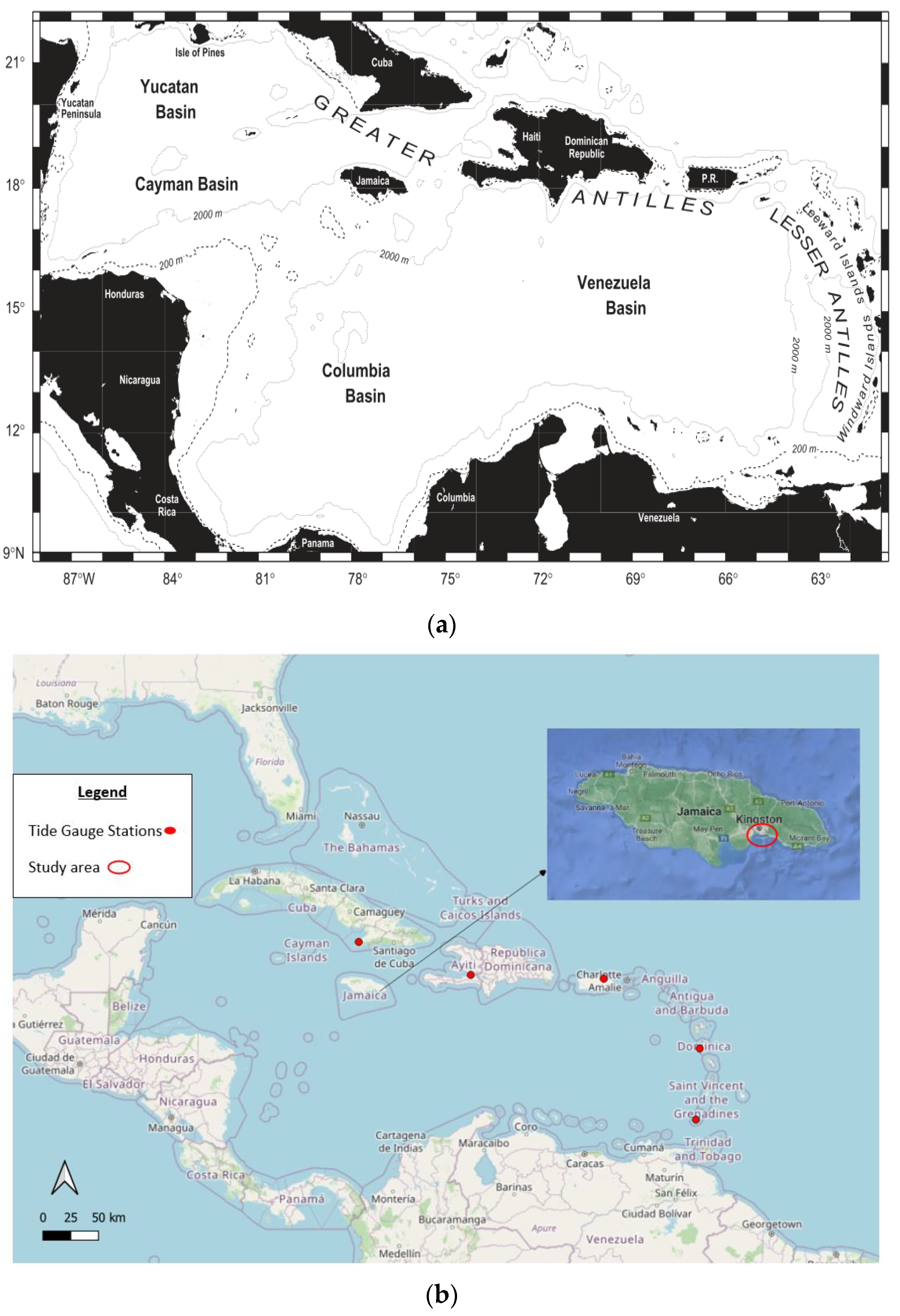
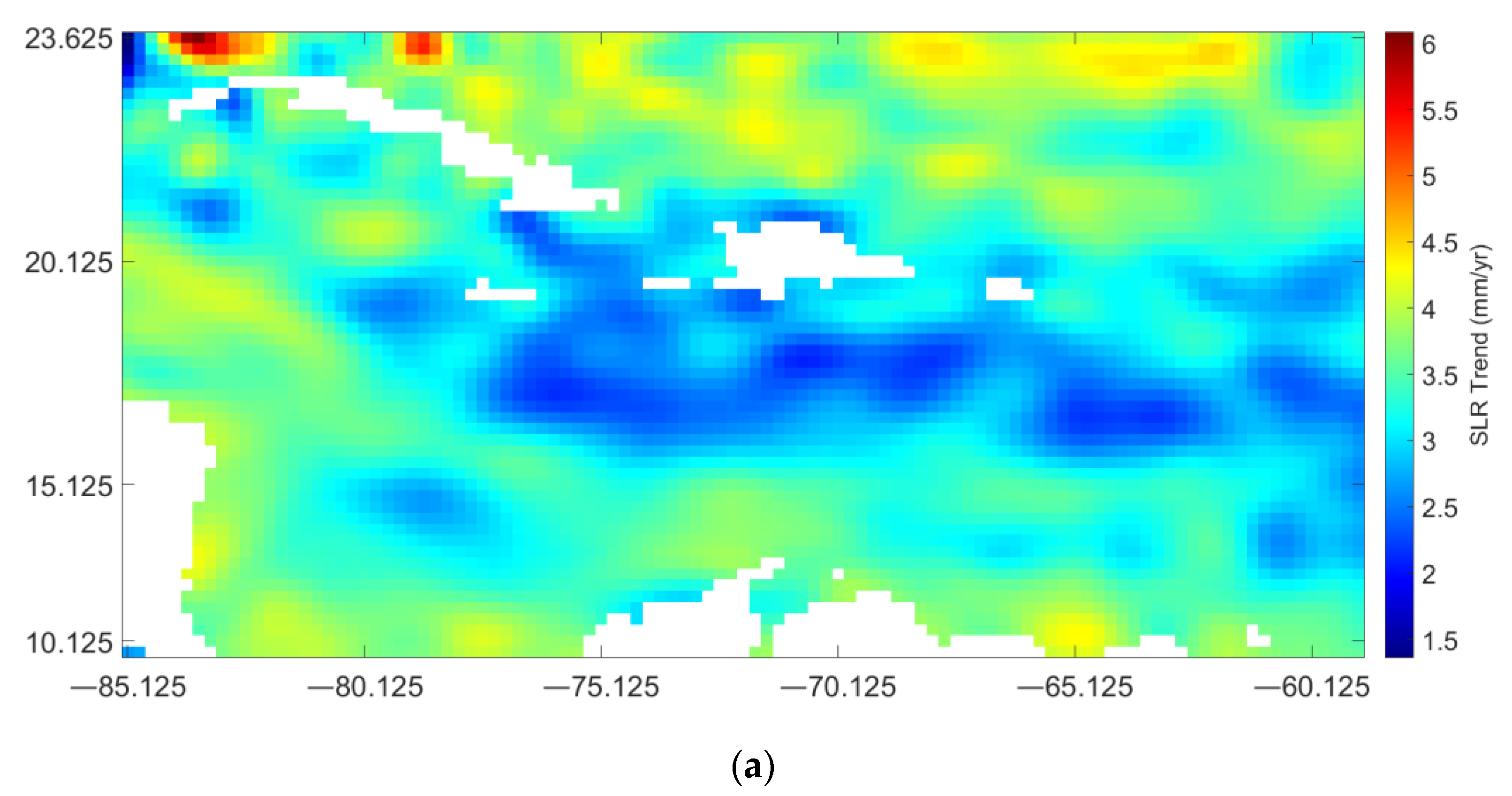
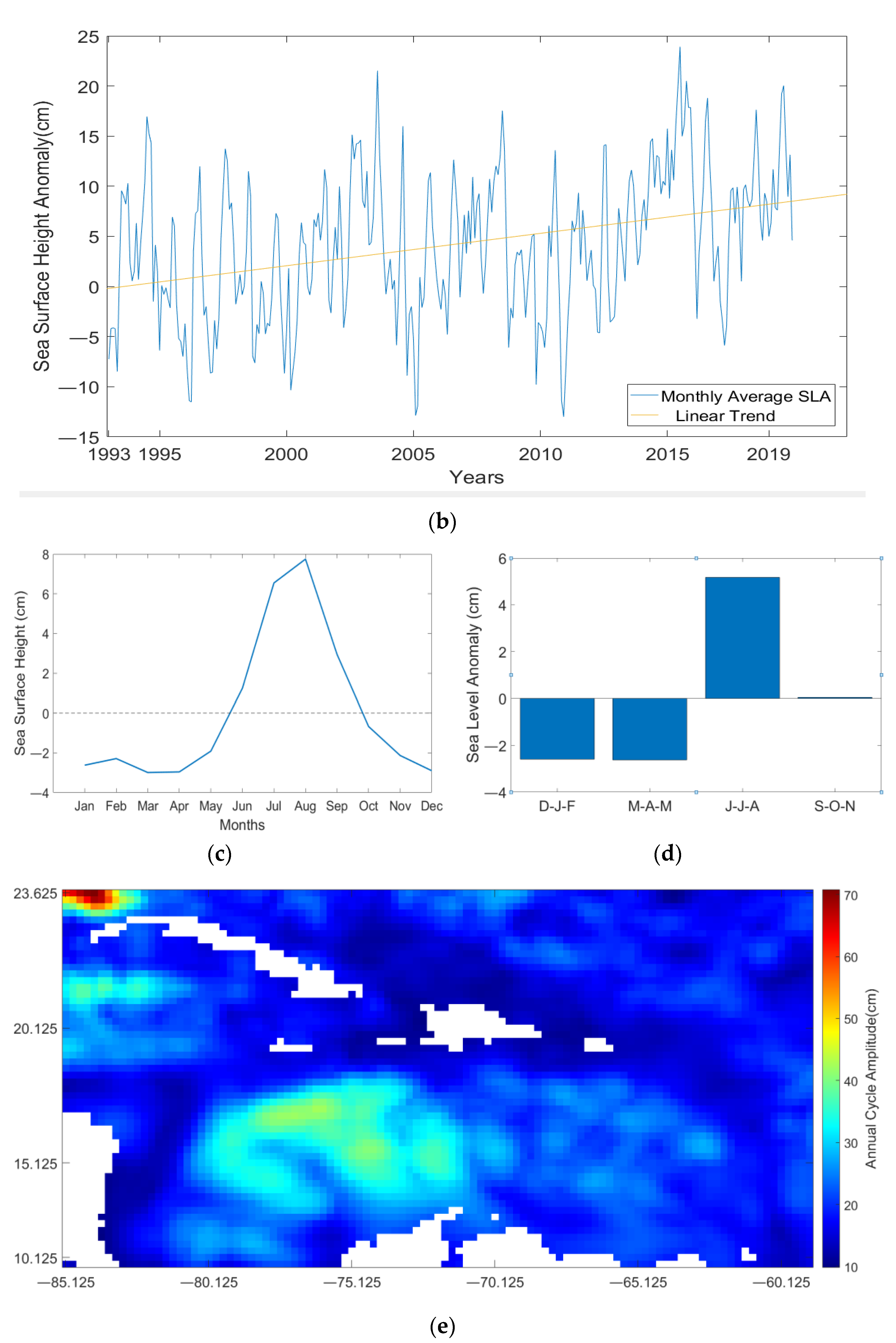
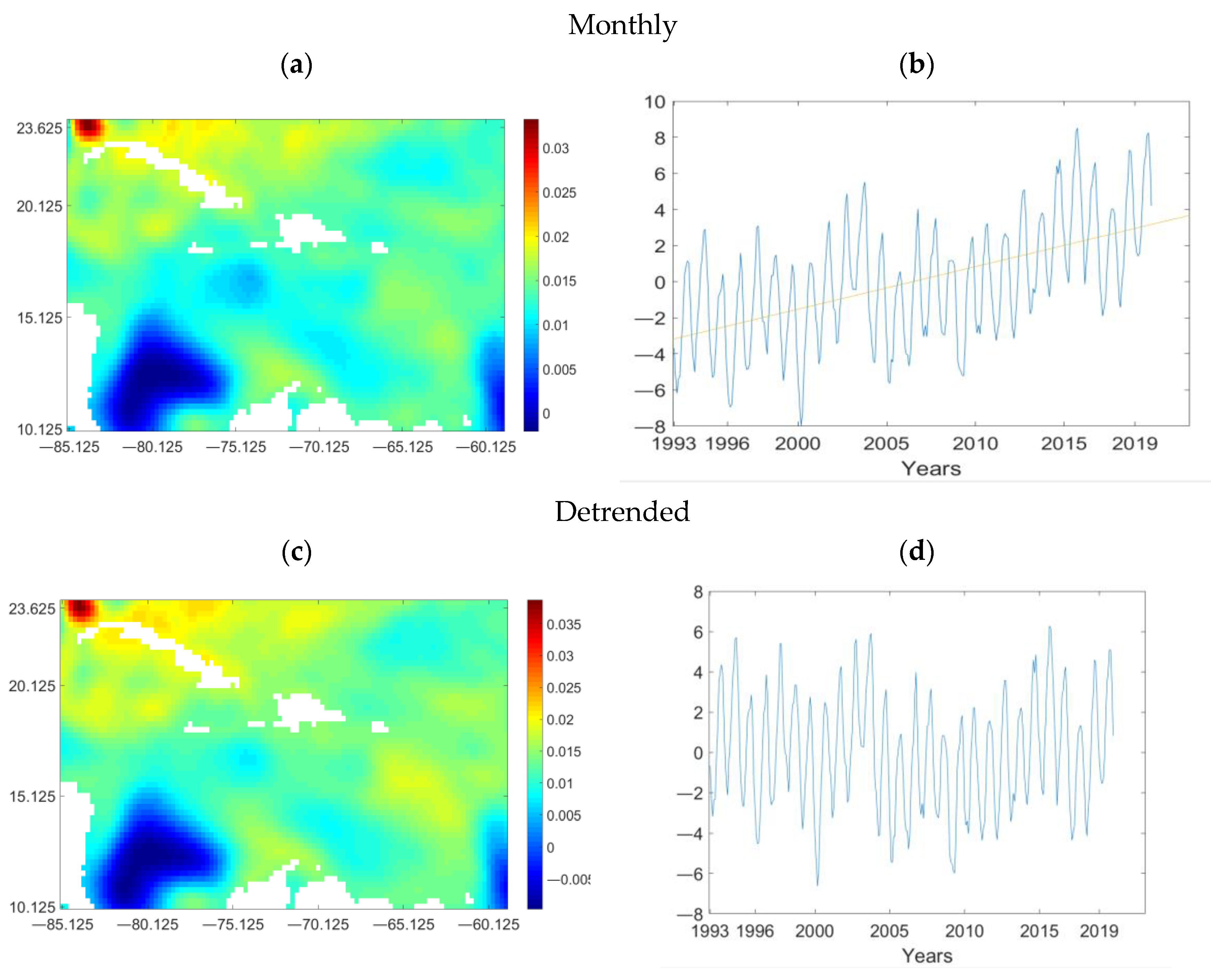

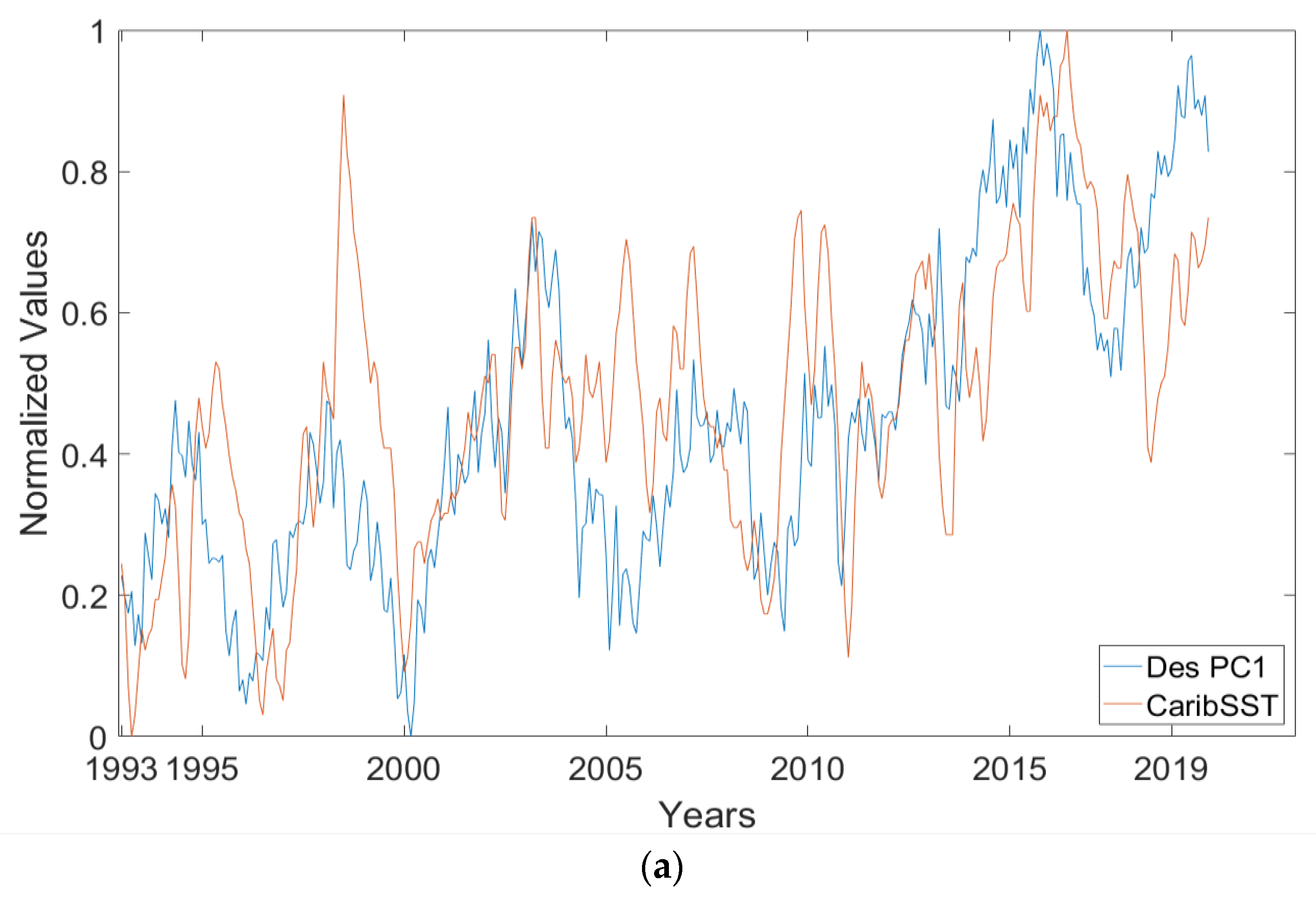

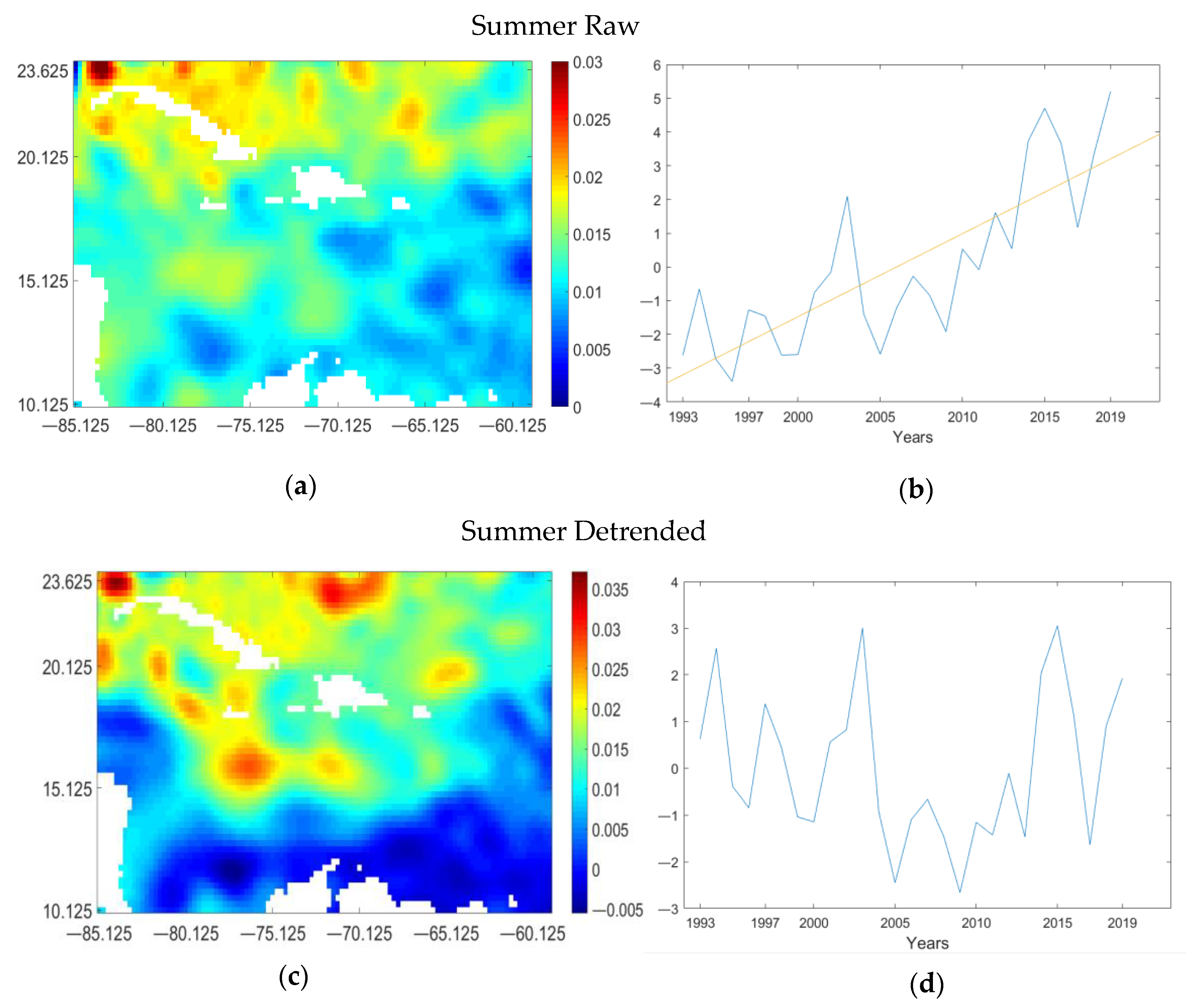
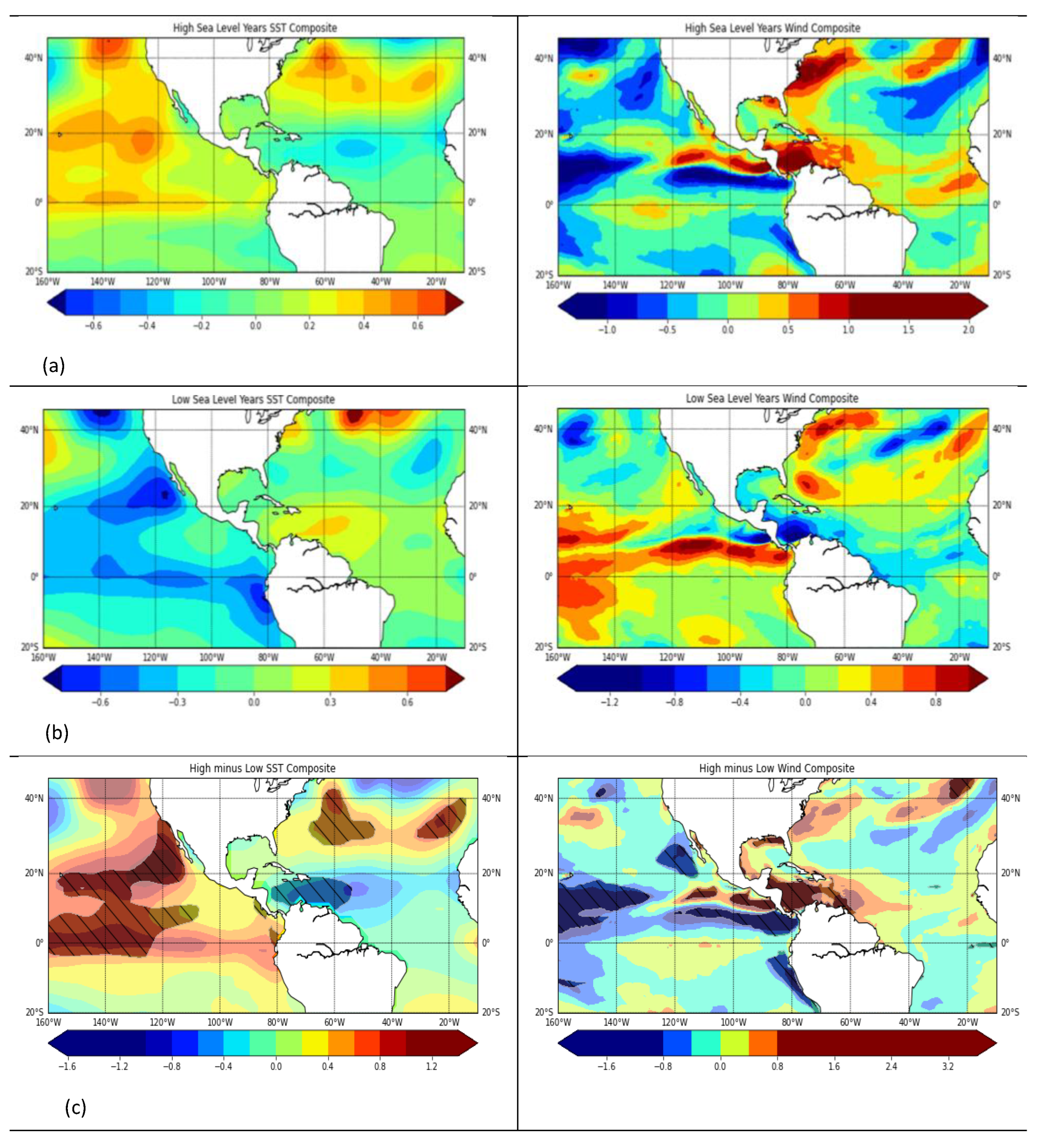
| Explained Variance (%) | ||||
|---|---|---|---|---|
| Raw | Detrended | Deseasoned | Detrended and Deseasoned | |
| PC1 | 36.84 | 29.88 | 26.68 | 54.28 |
| PC2 | 7.17 | 8.09 | 6.67 | 8.40 |
| PC3 | 5.65 | 6.06 | 6.36 | 6.47 |
| (a) Full Dataset | ||||||||||
| Variable | Nino 3.0 | Nino 3.4 | Carib SST | Wind | CLLJ | SLP | PDO | AMO | NAO | Pac–Atl |
| PC1_raw | 0.22 | 0.25 | 0.46 | −0.03 | −0.09 | −0.40 | −0.04 | 0.38 | 0.00 | −0.55 |
| PC2_raw | −0.19 | −0.19 | 0.03 | −0.49 | −0.50 | −0.25 | −0.24 | 0.11 | −0.01 | −0.29 |
| PC1_detrended | 0.20 | 0.25 | 0.18 | −0.09 | −0.18 | −0.46 | 0.08 | 0.23 | −0.02 | −0.61 |
| PC2_detrended | −0.19 | −0.19 | −0.02 | −0.51 | −0.54 | −0.32 | −0.22 | 0.11 | −0.04 | −0.35 |
| PC1_deseasoned | 0.31 | 0.33 | 0.63 | 0.20 | 0.21 | −0.01 | 0.08 | 0.27 | 0.05 | 0.09 |
| PC2_deseasoned | −0.06 | −0.07 | 0.11 | −0.05 | −0.11 | −0.08 | −0.13 | 0.18 | −0.09 | −0.09 |
| PC1_des_det | 0.55 | 0.60 | 0.29 | 0.71 | 0.57 | 0.21 | 0.54 | −0.13 | 0.29 | 0.66 |
| PC2_des_det | 0.04 | 0.01 | −0.14 | −0.09 | 0.12 | 0.01 | −0.07 | −0.13 | −0.06 | 0.07 |
| (b) Summer | ||||||||||
| Sum_PC1 | 0.21 | 0.22 | 0.45 | 0.53 | 0.43 | 0.20 | 0.05 | 0.28 | −0.24 | 0.11 |
| Sum_PC1_det | −0.29 | −0.39 | −0.02 | −0.68 | −0.54 | −0.58 | −0.51 | 0.16 | 0.05 | −0.50 |
| Low Sea Level Years | High Sea Level Years | |
|---|---|---|
| El Niño | 1994, 2015, 2018, 2019, | |
| La Niña | 1999, 2007, 2011 | 2008 |
| Neutral | 2005, 2006, 2013 | 2003 |
Disclaimer/Publisher’s Note: The statements, opinions and data contained in all publications are solely those of the individual author(s) and contributor(s) and not of MDPI and/or the editor(s). MDPI and/or the editor(s) disclaim responsibility for any injury to people or property resulting from any ideas, methods, instructions or products referred to in the content. |
© 2023 by the authors. Licensee MDPI, Basel, Switzerland. This article is an open access article distributed under the terms and conditions of the Creative Commons Attribution (CC BY) license (https://creativecommons.org/licenses/by/4.0/).
Share and Cite
Maitland, D.O.; Taylor, M.A.; Stephenson, T.S. Investigation of Multi-Timescale Sea Level Variability near Jamaica in the Caribbean Using Satellite Altimetry Records. J. Mar. Sci. Eng. 2023, 11, 1499. https://doi.org/10.3390/jmse11081499
Maitland DO, Taylor MA, Stephenson TS. Investigation of Multi-Timescale Sea Level Variability near Jamaica in the Caribbean Using Satellite Altimetry Records. Journal of Marine Science and Engineering. 2023; 11(8):1499. https://doi.org/10.3390/jmse11081499
Chicago/Turabian StyleMaitland, Deron O., Michael A. Taylor, and Tannecia S. Stephenson. 2023. "Investigation of Multi-Timescale Sea Level Variability near Jamaica in the Caribbean Using Satellite Altimetry Records" Journal of Marine Science and Engineering 11, no. 8: 1499. https://doi.org/10.3390/jmse11081499
APA StyleMaitland, D. O., Taylor, M. A., & Stephenson, T. S. (2023). Investigation of Multi-Timescale Sea Level Variability near Jamaica in the Caribbean Using Satellite Altimetry Records. Journal of Marine Science and Engineering, 11(8), 1499. https://doi.org/10.3390/jmse11081499





